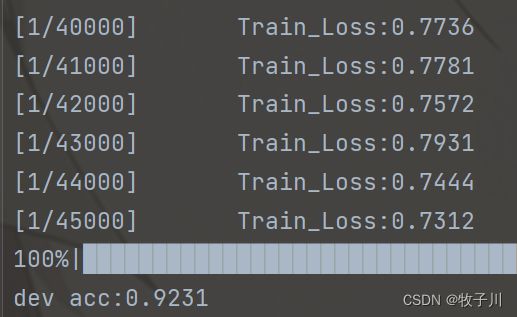深度学习-nlp系列(3)文本分类(Bert+TextCNN)pytorch
在前面两章讲解了 bert 和 TextCNN 模型,用这两个模型来进行文本分类。那我们就可以试一下将这两个模型进行融合来进行文本分类。
模型介绍
我们知道在进行模型融合时,要注意的时在第一个模型的输出要符合第二个模型的输入。
Bert 模型的输出是有不同的情况;TextCNN模型的输入是一个四维的,[bacth_size, 1, max_len, bedding]。
Bert 模型输出
图1 bert 模型输出
图2 bert 模型前三个输出解释
last_hidden_state:模型最后一层输出的隐藏状态序列。(batch_size, sequence_length, hidden_size)pooler_output:通常后面直接接线性层用来文本分类,不添加其他的模型或层。hidden_states:每层输出的模型隐藏状态加上可选的初始嵌入输出。12*(batch_size, sequence_length, hidden_size)
根据上面三个可知,如果我们要加上 TextCNN 模型,可以选择last_hidden_state和hidden_states,这两个不同的区别就是 last_hidden_state 是最后一层的输出,而hidden_states 是每一层的输出。因此对于 bert 模型的输出我们就有两种选择。
模型选择1:
图3 模型结构图1
我们以最后一层的模型输出的隐藏状态作为 TextCNN 模型的输入,此时要想在TextCNN 模型能正常进行训练,需要修改 shape 。
[batch_size, max_len, hidden_size] --》 [batch_size, 1, max_len, hidden_size]
out = hidden_out.last_hidden_state.unsqueeze(1) # shape [batch_size, 1, max_len, hidden_size]模型选择2:
图4 模型结构图2
我们以每一层的模型输出的隐藏状态作为 TextCNN 模型的输入,此时要想在TextCNN 模型能正常进行训练,需要修改隐藏状态。输出的第一层是我们不需要的(第一层是 embedding 层不需要),且 sequence_length 也是不需要的,需要将其去掉。
hidden_states = outputs.hidden_states # 13 * [batch_size, seq_len, hidden] 第一层是 embedding 层不需要
cls_embeddings = hidden_states[1][:, 0, :].unsqueeze(1) # [batch_size, 1, hidden]我们通过循环将剩余的层数给取出来,并将取出来的层数进行拼接作为 TextCNN 模型的输入。
for i in range(2, 13):
cls_embeddings = torch.cat((cls_embeddings, hidden_states[i][:, 0, :].unsqueeze(1)), dim=1)拼接后的输入的 shpe 为 [batch_size, 12, hidden],最后将该 shape 送入 TextCNN 模型进行训练。
数据处理
text = self.all_text[index]
# Tokenize the pair of sentences to get token ids, attention masks and token type ids
encoded_pair = self.tokenizer(text,
padding='max_length', # Pad to max_length
truncation=True, # Truncate to max_length
max_length=self.max_len,
return_tensors='pt') # Return torch.Tensor objects
# shape [max_len]
token_ids = encoded_pair['input_ids'].squeeze(0) # tensor of token ids torch.Size([max_len])
attn_masks = encoded_pair['attention_mask'].squeeze(0) # binary tensor with "0" for padded values and "1" for the other values torch.Size([max_len])
token_type_ids = encoded_pair['token_type_ids'].squeeze(0) # binary tensor with "0" for the 1st sentence tokens & "1" for the 2nd sentence tokens torch.Size([max_len])
if self.with_labels: # True if the dataset has labels
label = int(self.all_label[index])
return token_ids, attn_masks, token_type_ids, label
else:
return token_ids, attn_masks, token_type_ids模型准备
模型1:
class BertTextModel_encode_layer(nn.Module):
def __init__(self):
super(BertTextModel_encode_layer, self).__init__()
self.bert = BertModel.from_pretrained(parsers().bert_pred)
for param in self.bert.parameters():
param.requires_grad = True
self.linear = nn.Linear(parsers().hidden_size, parsers().class_num)
self.textCnn = TextCnnModel()
def forward(self, x):
input_ids, attention_mask, token_type_ids = x[0], x[1], x[2]
outputs = self.bert(input_ids=input_ids, attention_mask=attention_mask,
token_type_ids=token_type_ids,
output_hidden_states=True # 确保 hidden_states 的输出有值
)
# 取每一层encode出来的向量
hidden_states = outputs.hidden_states # 13 * [batch_size, seq_len, hidden] 第一层是 embedding 层不需要
cls_embeddings = hidden_states[1][:, 0, :].unsqueeze(1) # [batch_size, 1, hidden]
# 将每一层的第一个token(cls向量)提取出来,拼在一起当作textCnn的输入
for i in range(2, 13):
cls_embeddings = torch.cat((cls_embeddings, hidden_states[i][:, 0, :].unsqueeze(1)), dim=1)
# cls_embeddings: [bs, 12, hidden]
pred = self.textCnn(cls_embeddings)
return pred
模型2:
class BertTextModel_last_layer(nn.Module):
def __init__(self):
super(BertTextModel_last_layer, self).__init__()
self.bert = BertModel.from_pretrained(parsers().bert_pred)
for param in self.bert.parameters():
param.requires_grad = True
# TextCNN
self.convs = nn.ModuleList(
[nn.Conv2d(in_channels=1, out_channels=parsers().num_filters, kernel_size=(k, parsers().hidden_size),) for k in parsers().filter_sizes]
)
self.dropout = nn.Dropout(parsers().dropout)
self.fc = nn.Linear(parsers().num_filters * len(parsers().filter_sizes), parsers().class_num)
def conv_pool(self, x, conv):
x = conv(x) # shape [batch_size, out_channels, x.shape[1] - conv.kernel_size[0] + 1, 1]
x = F.relu(x)
x = x.squeeze(3) # shape [batch_size, out_channels, x.shape[1] - conv.kernel_size[0] + 1]
size = x.size(2)
x = F.max_pool1d(x, size) # shape[batch+size, out_channels, 1]
x = x.squeeze(2) # shape[batch+size, out_channels]
return x
def forward(self, x):
input_ids, attention_mask, token_type_ids = x[0], x[1], x[2] # shape [batch_size, max_len]
hidden_out = self.bert(input_ids, attention_mask=attention_mask, token_type_ids=token_type_ids,
output_hidden_states=False)
out = hidden_out.last_hidden_state.unsqueeze(1) # shape [batch_size, 1, max_len, hidden_size]
out = torch.cat([self.conv_pool(out, conv) for conv in self.convs], 1) # shape [batch_size, parsers().num_filters * len(parsers().filter_sizes]
out = self.dropout(out)
out = self.fc(out)
return out模型训练
def train(model, device, trainLoader, opt, epoch):
model.train()
loss_sum, count = 0, 0
for batch_index, batch_con in enumerate(trainLoader):
batch_con = tuple(p.to(device) for p in batch_con)
pred = model(batch_con)
opt.zero_grad()
loss = loss_fn(pred, batch_con[-1])
loss.backward()
opt.step()
loss_sum += loss
count += 1
if len(trainLoader) - batch_index <= len(trainLoader) % 1000 and count == len(trainLoader) % 1000:
msg = "[{0}/{1:5d}]\tTrain_Loss:{2:.4f}"
print(msg.format(epoch + 1, batch_index + 1, loss_sum / count))
loss_sum, count = 0.0, 0
if batch_index % 1000 == 999:
msg = "[{0}/{1:5d}]\tTrain_Loss:{2:.4f}"
print(msg.format(epoch + 1, batch_index + 1, loss_sum / count))
loss_sum, count = 0.0, 0
训练结果
由于训练时间长,我对这两个模型都只训练的一次,来看模型在验证集上的准确率。发现在只训练一轮时,模型1的准确率高于模型2的准确率。
BertTextModel_encode_layer
图5 模型2输出
BertTextModel_last_layer
图6 模型1输出1
图7 模型1输出2
模型预测
选取 BertTextModel_last_layer 模型的模型文件来进行预测
图8 模型1预测结果
源码获取
bert-TextCNN 文本分类







